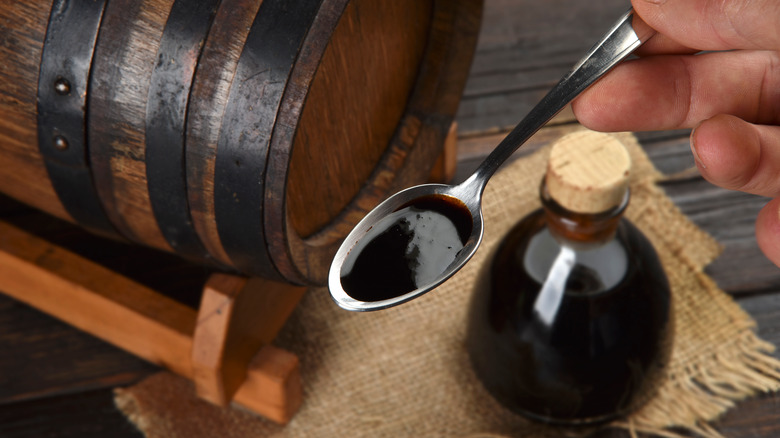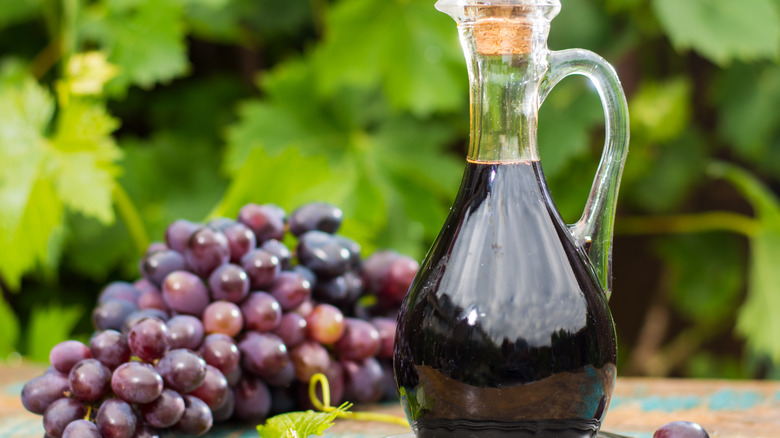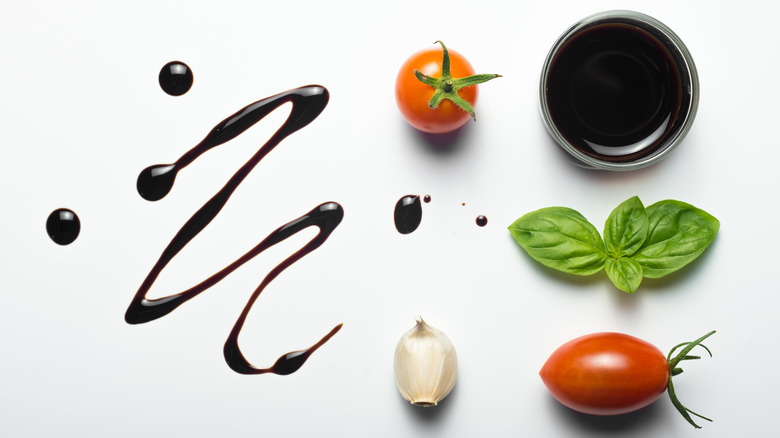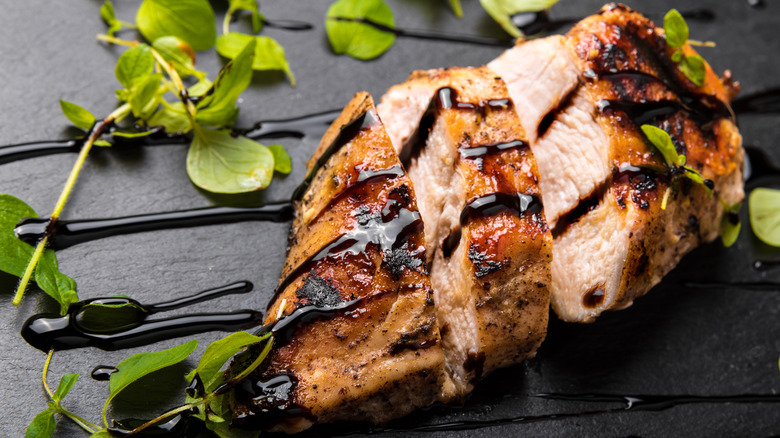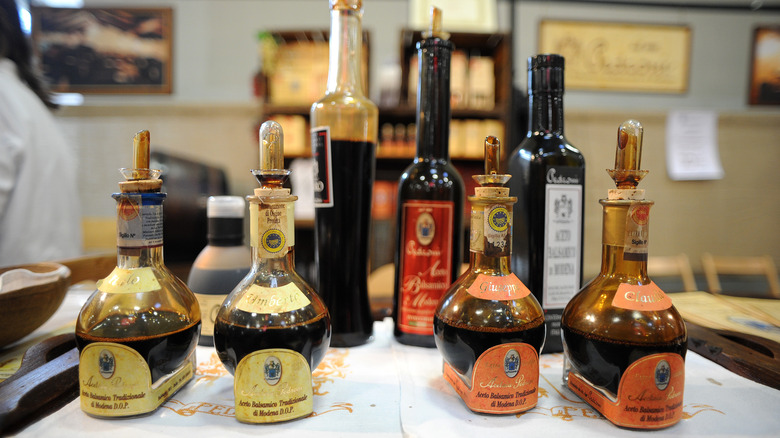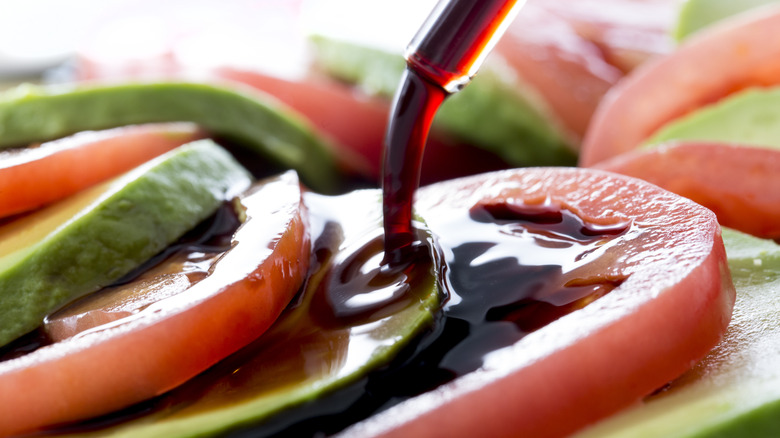Everything You Need To Know About Balsamic Vinegar
You might use balsamic vinegar a lot when cooking, or you might have noticed it called for in a ton of recipes. It's often used as a drizzle, glaze, or a dip. It's definitely a versatile ingredient. But what is it exactly, where does it come from, and what does it taste like?
As you might have gathered, balsamic vinegar is a type of vinegar, having that signature, strong scent and flavor that falls somewhere between sour and bitter, and definitely acidic. But there are several different types of vinegar, and even different kinds of balsamic vinegar itself (via ChowHound).
Balsamic is made from white grapes, but it differs from another pantry staple, white vinegar, in some key respects. Though also made with white grapes, white vinegar contains acetic acid, which is derived from grain or grain alcohol. It possesses an overwhelming flavor that is best used in small quantities, often combined with other condiments like ketchup or barbecue sauce to balance the sweetness. The similarity between Balsamic and white vinegar ends with the grapes, as Balsamic vinegar is produced in a totally different way.
How is balsamic vinegar made?
When it comes to balsamic vinegar and how it is made, there are two different types to look at: traditional and modern. Traditional balsamic vinegar is made using "grape must" — juice from pressed white grapes that is boiled down into a syrup, fermented, acidified, and then aged in barrels for several years (via ChowHound). Because traditional balsamic vinegar has a more singular and lengthy production process, the batches are smaller, which makes the vinegar more expensive and harder to find (via Simply Recipes).
Modern balsamic vinegar is much more common, and is created using a (you guessed it) modern method that speeds up the process and thus makes it easier to produce in larger quantities at faster rates. This method combines grape must with wine vinegar, and while traditional balsamic vinegar is aged anywhere from 12 to 25 years (or more), modern balsamic vinegar is only aged from two months to three years.
What does balsamic vinegar taste like?
Balsamic vinegar is dark brown in color and can vary from being a relatively thin liquid to a thicker syrup (from Simply Recipes). It has a complex taste that's acidic, tart, sweet, with varying degrees of sweetness depending on production method. It has a strong, pungent scent, and you can often sense the acidity when smelling it. Generally speaking, the more traditional the balsamic vinegar, the thicker and sweeter the flavor; the more commercial the balsamic vinegar, the thinner and more tart and acidic.
Because there are different styles of balsamic vinegar that range in sweetness, thickness, tartness, and acidity, the flavor profiles can vary significantly, as can the uses. Due to its consistency and sweeter flavor, traditional balsamic vinegar is great for drizzling over caprese salad or topping with olive oil to use as a dip for fresh bread. Back in the origin days of balsamic vinegar (and even today), spoonfuls of the fermented condiment were even taken as elixirs and tonics (via Spruce Eats). Modern or commercial-grade balsamic vinegar is used more widely for incorporating while cooking, perhaps as a marinade or a sauce base, given its less sweet flavor and thinner consistency.
How to cook with balsamic vinegar
Traditional balsamic vinegar, with its thick consistency and sweetness, is used mostly for drizzles and dipping so the flavor can be truly cherished — it stands on its own as a condiment, and can be used to complement bread, crackers, cheese, vegetables, or even creamy desserts (via Serious Eats). It is rarely, if ever, used for cooking, where it would lose its distinctive flavor.
Modern or commercial-grade balsamic vinegar is what you want to use when creating salad dressings from scratch, mixing together marinades for meats or vegetables, or enhancing soups, stews, and sauces. Moreover, there are a variety of "balsamic-inspired products" that branch out from the standard vinegars. These include glazes, ketchups, pearls, syrups, and balsamic vinegars that are infused with different flavors, like fruit, herbs, and spices. Depending on what you're aiming to cook or create, what a recipe calls for, or which flavors you're trying to complement or contrast, you might consider different varieties and flavors of balsamic vinegar.
Where to buy balsamic vinegar
Because modern or commercial-grade balsamic vinegar is much more common and mass produced, it can be found easily in pretty much any grocery store. There are many different brands available, so you can experiment with various kinds to find which ones you like the best or find the most useful when cooking. Balsamic vinegar is typically found in the condiments aisle, and there is a variety that will work for any budget or intended use (via Bon Appetit). Commercial-grade balsamic vinegar is also available online, from retailers like Amazon.
If you're looking for more traditional-style or locally made balsamic vinegar, you'll want to research your area for specialty stores that may sell these rarer, pricier varieties. While balsamic vinegar-specific stores are not as common, you can often find authentic and high-quality balsamic vinegar at local olive oil retailers or at high-end markets like Williams Sonoma.
Nutritional information about balsamic vinegar
According to Medical News Today, balsamic vinegar can have a number of positive health benefits. Because balsamic vinegar contains antimicrobial compounds, acetic acid, and antioxidants, it is thought to help improve skin complexion over time. Don't put any directly on your skin, though; because of its dark-brown coloring and high acidity, balsamic vinegar will stain the skin (and your clothes, for that matter, so if you're eating or cooking some, be sure to have a Tide To-Go Stick at the ready).
Balsamic vinegar is also useful in aiding digestion due to its high content of acetic acid, which contains probiotics. This means that, whether you've marinated your chicken or have crafted a balsamic vinaigrette salad dressing, you're benefiting your gut health and potentially your immune system as well. Finally, balsamic vinegar may be helpful to combat acid reflux and heartburn, though Medical News Today cautions this may not work for everyone. If you try it, be sure to start with small amounts and wait several hours to see if your symptoms get better or worse!
